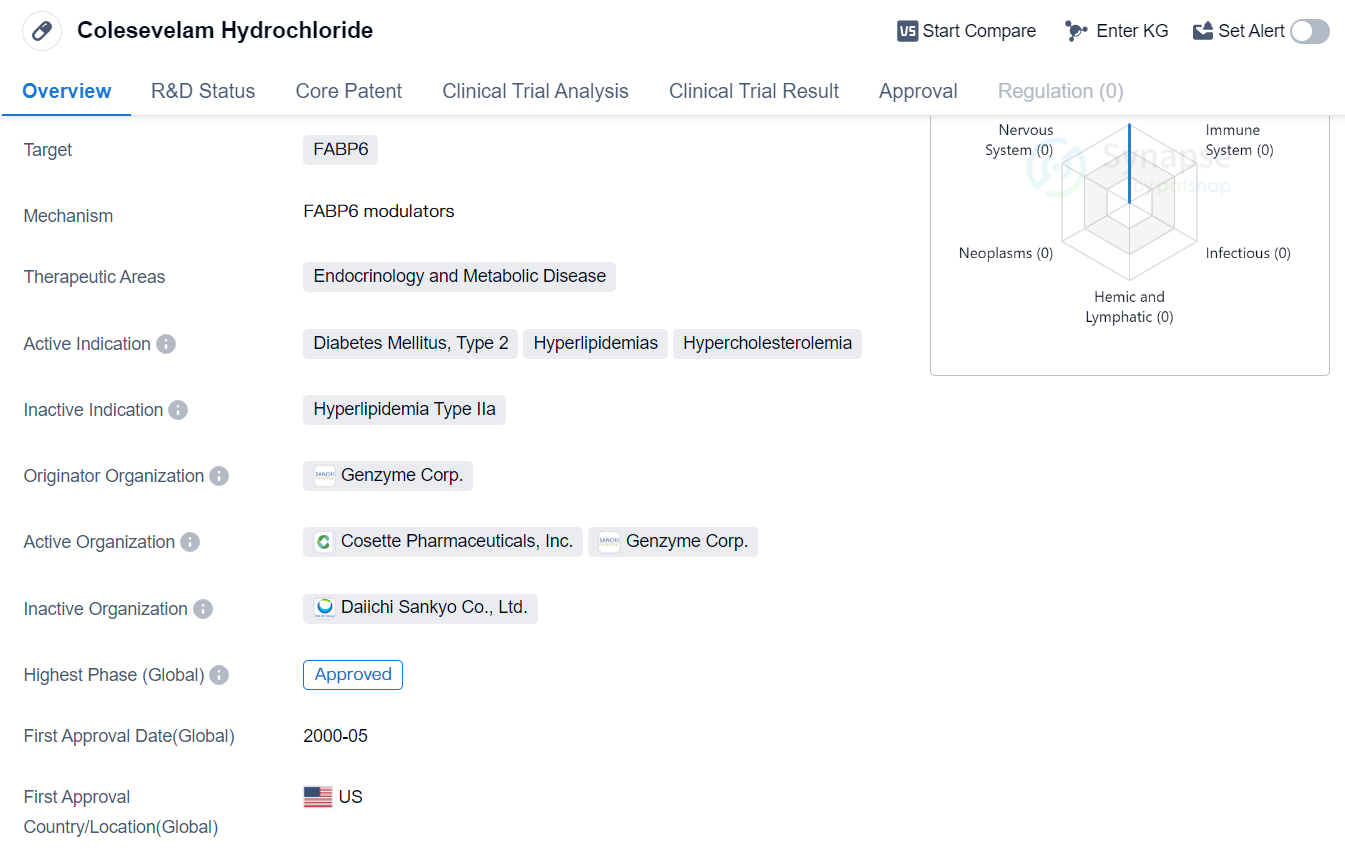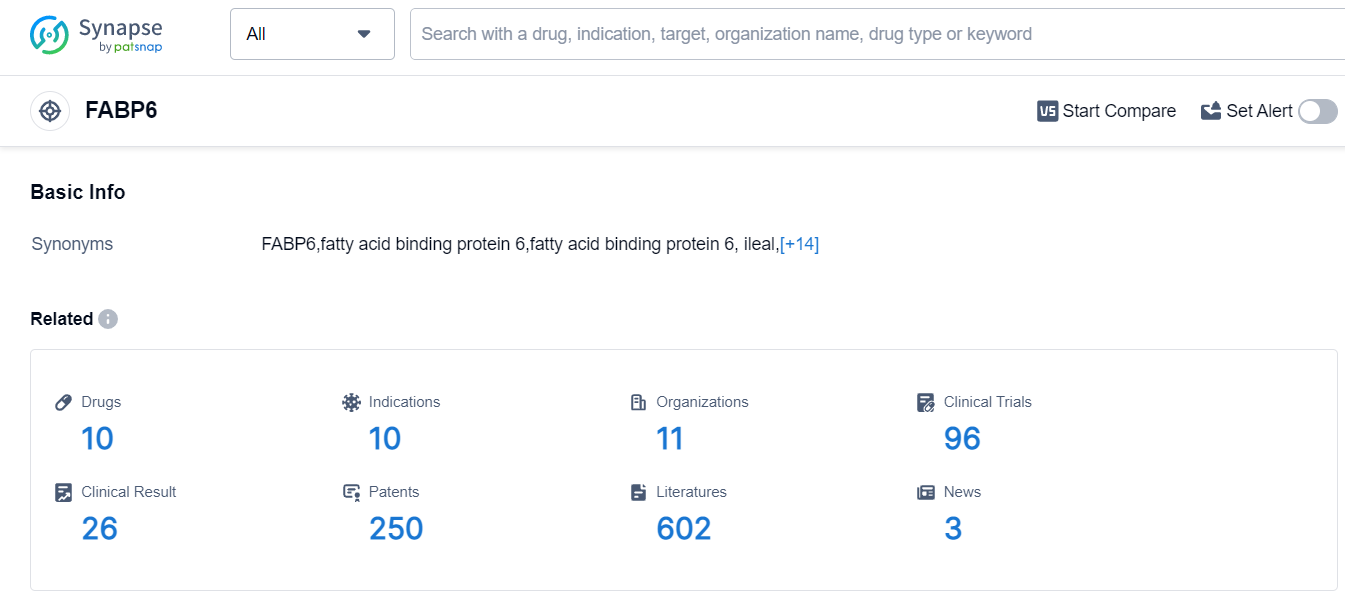Unleashing the Power of Colesevelam Hydrochloride: A Comprehensive Review on R&D Breakthroughs
Colesevelam Hydrochloride's R&D Progress
Colesevelam Hydrochloride is a small molecule drug that falls under the therapeutic areas of endocrinology and metabolic disease. It specifically targets FABP6, a protein involved in various metabolic processes. The drug has been approved for the treatment of diabetes mellitus type 2, hyperlipidemias, and hypercholesterolemia.
The originator organization of Colesevelam Hydrochloride is Genzyme Corp., a renowned pharmaceutical company known for its expertise in developing innovative therapies. The highest R&D phase of this drug is approved.
The first approval of Colesevelam Hydrochloride took place in May 2000 in the United States. Diabetes mellitus type 2 is a chronic condition characterized by high blood sugar levels due to insulin resistance or insufficient insulin production. Colesevelam Hydrochloride is prescribed to help manage blood sugar levels in patients with this condition. It works by binding to bile acids in the intestine, reducing their reabsorption and increasing their excretion. This mechanism of action has been shown to improve glycemic control in patients with diabetes.
Hyperlipidemias and hypercholesterolemia refer to conditions characterized by high levels of lipids, such as cholesterol and triglycerides, in the blood. Colesevelam Hydrochloride is used as an adjunct therapy to diet and exercise to lower LDL cholesterol levels in patients with these conditions. By binding to bile acids, it increases the excretion of cholesterol, leading to a reduction in LDL cholesterol levels.
👇Please click on the image below to directly access the latest data (R&D Status | Core Patent | Clinical Trial | Approval status in Global countries) of this drug.
Mechanism of Action for Colesevelam Hydrochloride: FABP6 modulator
FABP6 modulators refer to substances or compounds that can interact with and affect the activity of FABP6 (Fatty Acid-Binding Protein 6). FABP6 is a protein found in the human body that plays a role in the transport and metabolism of fatty acids.
From a biomedical perspective, FABP6 modulators can have therapeutic implications in various conditions related to lipid metabolism and bile acid homeostasis. By modulating the activity of FABP6, these compounds may potentially regulate the absorption, transport, and metabolism of fatty acids and bile acids in the body.
The term "modulators" suggests that these substances can either enhance or inhibit the function of FABP6, depending on their specific mechanism of action. This modulation can be achieved through various means, such as binding to FABP6 and altering its conformation or interfering with its interaction with other molecules.
The development of FABP6 modulators holds promise for potential therapeutic interventions in disorders like hyperlipidemia, atherosclerosis, and cholestatic liver diseases. However, it's important to note that the specific details and applications of FABP6 modulators may vary depending on ongoing research and clinical trials.
Drug Target R&D Trends for Colesevelam Hydrochloride
The analysis of the target FABP6 reveals a competitive landscape with multiple companies actively involved in research and development. Sanofi, Cosette Pharmaceuticals, Inc., and Ipsen SA are leading the way with their R&D progress. The approved drugs under the target FABP6 have indications related to hypercholesterolemia, diabetes mellitus type 2, hyperlipidemias, and bile acid malabsorption. Small molecule drugs are the most rapidly progressing drug type, indicating a focus on traditional pharmaceutical compounds. The United States and the European Union are the key locations for the development of drugs targeting FABP6. Overall, the target FABP6 shows promise in addressing various indications, and further research and development efforts are expected to drive future advancements in this field.
According to Patsnap Synapse, as of 14 Sep 2023, there are a total of 10 FABP6 drugs worldwide, from 11 organizations, covering 10 indications, and conducting 96 clinical trials.
Please click on the picture link below for free registration or log in directly if you have a freemium account, you can browse the latest research progress on drugs, indications, organizations, clinical trials, clinical results, and drug patents related to this target
Conclusion
Overall, Colesevelam Hydrochloride is a small molecule drug developed by Genzyme Corp. It has been approved for the treatment of diabetes mellitus type 2, hyperlipidemias, and hypercholesterolemia. Its mechanism of action involves targeting FABP6 and binding to bile acids to improve glycemic control and lower LDL cholesterol levels. The drug has undergone extensive clinical trials and regulatory processes, culminating in its approval in 2000 in the United States.






